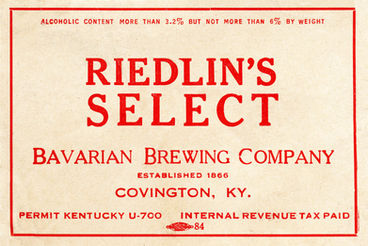
THE BEGINNINGS
- Of Bavarian Brewery
THE BEGINNINGS
- Of Bavarian Brewery
ADS - From Newspapers
BEER LABELS
LABELOLOGY
The collecting and study of beer labels, has been referred to as labelology, by the late Bob Kay, who published US Beer Labels. Bob grouped labels into the following chronological categories:
-
Pre-Prohibition of "Pre-Pro" (Before 1920, but WWI limited Beer to 2.75% two years earlier).
-
Prohibition (Mostly 1919-1932; Use of h & L permits with limited alcohol (<0.5 to 2%.)
-
U-Permits (Normally 1933 - 1935).
-
IRTP - Internal Revenue Tax Paid (1935 - 1950)
-
No IRTP shown. (March, 1950 - Present).
A Video Of
Part 1: Bavarian Brewing Co. Labels
Labels for the categories mentioned above, except for the Prohibition Period, are displayed below for the Bavarian Brewing Co. Even though the brewery had planned to bottle low alcoholic "near beer" and soft drinks during Prohibition, it appears this may have never occurred - or if it did, production lasted only briefly, perhaps for about a year.
THE EARLIEST LABELS -
PRE-PROHIBITION
Throughout most of the 1800s, beer was primarily consumed from kegs, and the bottles used in distribution were embossed with the brewer's name and location, making the need for paper labels mostly unnecessary. (See Beer Bottles.) However, in the late 1800s advances made in developing the bottle cap or crown as well as in pasteurization and refrigeration made it more practical to bottle and distribute beer. (See Crowns.) The introduction of efficient bottling machinery could more quickly bottle beer and made it easier to affix labels to the bottles. Consequently, paper beer labels emerged as standard practice from approximately 1900 until Prohibition began in 1919. These Pre-Prohibition labels represent an important chapter in American brewing history and are highly prized by collectors specializing in this area today. Many examples are exceedingly rare, especially in good condition. The Pre-Prohibition labels for Bavarian Brewing Co. displayed below are from the early 1900s and have been restored from images obtained from the Schott Collection at the Behringer - Crawford Museum.

Besides the labels shown, shortly before Prohibition began the brewery also had labels for an ale, porter, malt tonic, bock, malt tonic according to an audit report. There may even have been a Blue Ribbon Beer and some near beer or non-alcoholic beverages produced during the beginning of Prohibition. Should anyone have copies of these or any other labels that are not displayed herein, we'd be very interested in obtaining copies or acquiring them. (Please see Donate.)

LABELS AFTER PROHIBITION
1935-1937. In mid-1935, approximately three years after Prohibition's repeal, the Bavarian Brewery resumed operations under new leadership. Murray Voorhees, who had married Rosemary Riedlin - granddaughter of founder William Riedlin - spearheaded this revival effort with a group of investors. Voorhees and his associates evidently had difficulty securing adequate financing and the venture suffered from inadequate capitalization, preventing them from achieving profitability as the economy was also struggling from the Great Depression. By mid - 1937, these financial challenges forced the brewery into receivership (detailed further in Section 6. The Great Depression & A Reopening.) During this initial period, the brewery may have distributed only draft beer in kegs. It is unclear what labels, if any, may have been used. Should anyone with information about labeling during this period, they are encouraged to contact us.)
DIFFERENT LABELS REQUIRED FOR BAVARIAN'S PRIMARY MARKETS IN OHIO AND KENTUCKY.
Prior to Prohibition, there were no minimum age requirements for the consumption of alcoholic beverages in most states. That changed after Prohibition, when all states adopted age limitations for the consumption of alcoholic beverages, which could vary. The minimum age for drinking any alcoholic beverage in Kentucky was 21 years. However, Ohio allowed anyone 18 or over to obtain a lower alcoholic beer by weight (ABW) of only 3.2% instead of the normal alcoholic level which was usually over 5%, and anyone 21 or over could obtain the higher alcoholic beer - as well as any other alcoholic beverage. (Please know that another measure of alcohol is alcohol by volume, and beer that is 3.2% ABW is equivalent to about 4% ABV). Because of these different legal requirements, it was necessary for any brewery in the Cincinnati area doing business in both Ohio and Kentucky to have two labels for Ohio showing different alcoholic contents, and a different label for Kentucky that did not need to show any alcoholic content. An interesting phenomenon in Ohio is that many establishments near college campuses where most students were under 21 would only serve beer with the lower alcoholic content, and were therefore known as 3.2 or three-two bars. However, liquor laws began changing in the 1980s and 3.2% beer is no longer available in Ohio - or in nearly any other state.
As illustrated below, Bavarian Brewing Co. labels for their brands changed over the years. Shortly after Prohibition, there could be some color differences between the Ohio and Kentucky labels. However, for most periods the labels for these states were often nearly identical to one another with the only difference being the notice (or lack of notice) for the alcoholic content. However, the labels for bottles larger than 12 ounces, usually had a somewhat different shape, and they could also have a different design. Further, the keg labels were usually different from those for bottles.
c. 1937-1938. RIEDLIN'S SELECT BEER began under the short time the Voorhees group owned Bavarian, and may have been one of the first labels used, in 1937 or 1938. The label shown is an Ohio U-Permit label. However, shortly after the Schott Brothers began operating the brewery in 1938, this brand was discontinued.
U Permits: After Prohibition each brewer was assigned a U-Permit number. For Bavarian that number was U-700, as shown on the Riedlin's Select label above. Normally U-Permits were only shown on labels between 1932 and 1935. However, some brewers, including the Bavarian Brewing Co., continued to use them for some time afterwards.
Internal Revenue Tax Paid (IRTP): This notice was indicated on all labels after Prohibition until March of 1950.
c. 1938. BAVARIAN BEER was a draft beer and BAVARIAN MASTER BRAND BEER was a pasteurized beer. These were the major brands brewed and bottled by the Schott Brothers after they began operating the Bavarian Brewing Co. in early 1938. The quart labels on the left and right below were only believed to be used for about a year.
c. 1938. CINCINNATI'S PRIDE BRAND BEER. Besides the brands shown above, the Schott Brothers also offered this brand in recognition of Cincinnati's Union Terminal, which opened in 1933. It was a brand first used by the Old Munich Brewery, which operated for only a year around 1936. This brand was then apparently acquired by the Schott Brothers. However, within a year or two, it appears the Schott Brothers discontinued this brand and concentrated on the two previously mentioned brands, and an ale named after their family. The labels below are for Ohio.


c. 1938. BAVARIAN MASTER BRAND BEER featured an oval label by late 1938, which was only used for a couple of years. The first two labels shown below are for Ohio indicating different alcoholic contents and the last one is a Kentucky label.

c. 1940 - c. 1942. BAVARIAN MASTER BRAND was revised with a "Blue and Gold" angular design beginning around 1940, as shown below. The first two 12 oz. IRTP labels show different alcoholic contents for Ohio, and the last label is for Kentucky.
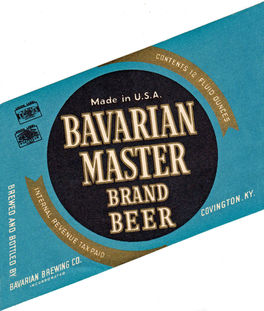
c. 1942 - c. 1946. BAVARIAN MASTER BRAND was revised to an "Orange and Blue" angular design with some gold highlights beginning around 1942, as depicted below. The last IRTP label shown is for a Bock Beer that was usually offered in March for only a month or two. Below it our two Ohio labels with different alcoholic content and a Kentucky label, and the Kentucky label on the bottle is a different variation, as it excludes any gold.
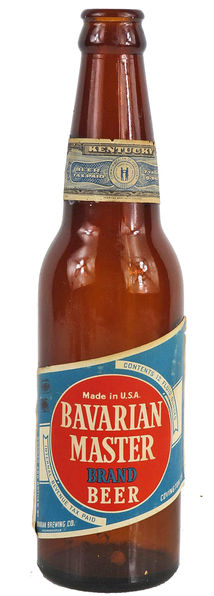



c. 1935 - 1940s. State Tax Paid Neck Labels. Both Ohio and Kentucky required tax paid labels to usually be placed on the neck of a bottle. Shown is this neck label on a bottle for Kentucky above and also a neck label for Ohio. Beginning around the 1940s and early 1950s these labels were no longer required, because the tax paid was placed on the side of the crown.
Please refer to Crowns / Bottle Caps.
c. 1940 - Mid 1950s. SCHOTT ALE was introduced by the Schott Brothers around the same time Cincinnati's Pride Brand Peer was discontinued. Besides Bavarian Draft Beer and Master Brand Beer, Schott Ale, was continued into the mid 1950s. In the first row of gold labels, the first one is an Ohio label with an alcoholic content less than 7%, the second is a Kentucky 12 oz. label and the third is a Kentucky quart label. The second row of silver labels show an Ohio label a less than 7% ABW and the other two are Kentucky labels. It is believed the gold labels may have preceded the silver labels.
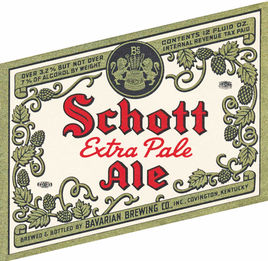

c. 1943-1945. COVINGTON ALE. During WWII, ingredients for beer were limited and a certain proportion of all beer and ale produced was required to be provided to the Allied Troops to help boost their morale during non-combat periods. Since these alcoholic beverages were not intended for domestic consumption, the Internal Revenue Tax was withdrawn as shown on the accompanying label. Bavarian Brewing provided Covington Ale for this purpose with a 12 oz. label very similar to Schott Ale, as shown.

1946 - 1950. BAVARIAN'S OLD STYLE BEER replaced both Bavarian Beer (draft) and Bavarian Master Brand Beer, as Bavarian Brewing Co. decided to consolidate its brand under one primary name.

Beer Neck Labels. Since state beer tax paid was placed on crowns instead neck labels starting in the late 1940s and early 1950s, the neck label usually corresponded to the name of the beer.
1946 -1950. BAVARIAN'S OLD STYLE BEER in draft was offered, but required a warning label to indicate the beverage needed to be kept cold, or it would spoil. A label indicating this warning is displayed for a 1/2 gallon bottle.
However, Bavarian's Old Style Beer was mostly pasteurized, especially in 12. oz and quart bottles. Shown below are IRTP Ohio labels indicating two different alcoholic contents and a Kentucky label.


The labels below were likely for kegs. They indicated a U Permit, even though they were apparently issued in the late 1940's and was not required.
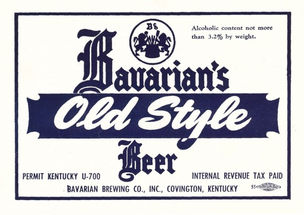
1946 -1950. BAVARIAN'S OLD STYLE BOCK BEER was offered every spring, with a label that showed a goat, as indicated by the 12 oz. labels below, with the first two respectfully showing the alcoholic content for Ohio and the last one for Kentucky. These labels indicated Internal Revenue Tax Paid (IRTP), which was no longer needed beginning in March of 1950.

c 1950 -1957. BAVARIAN'S OLD STYLE BEER looked almost the same as it did previously before early 1950, except the IRTP notice was omitted. The first two 12 oz. labels are for Ohio showing different alcoholic contents, and the last label is for Kentucky.
Beer Neck Labels with Logos. Besides having a neck label with the name of the beer, neck labels could also provide a logo consistent with the advertising being used for a particular brand.

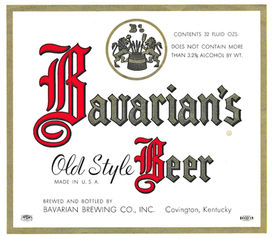
c 1950 -1957. The labels below are similar to those above without the IRTP notice, but are for quart bottles. The first two 32 oz. labels are for Ohio showing different alcoholic contents, and the last label is for Kentucky.

1957 - 1959. BAVARIAN'S SELECT BEER. Bavarian revamped their label along with a change to their name in 1957. The new name was , basically replacing Old Style with Select. The new label was on a foil backing and used bright colors and three flags to indicate Time / Tradition / Skill. There was also a new reference to their brand as Bavarian/s, which referenced Select as well as the 's. A great deal of analysis, effort and cost went into this new design. (See History: Bavarian's New Look).


INTERNATIONAL BREWERIES INC.
Bavarian Brewing Co. was owned by the Schott family including the daughter of William Riedlin, her husband Will, their two sons, and Will's brother. In 1959, Bavarian merged with a regional brewer, International Breweries Inc., or IBI. The Bavarian Brewery or the Covington (KY) plant was operated by IBI for several years thereafter - until 1966. As a division of IBI, Bavarian's Select Beer was brewed at three of the other four plants operated by IBI. Additionally, the Bavarian plant also brewed several different IBI brands. The video on the side explores these various brands and labels. Even though IBI changed nearly all of its other labels, it retained Bavarian/s design with the three flags.
Part II: IBI Labels at Bavarian Brewery
c. 1959 - 1966. BAVARIAN/S SELECT BEER. To apparently reduce some costs, IBI modified Bavarian/s label by eliminating the foil backing. In doing so initially, IBI soon discovered the yellow lettering was too light to be easily read, as shown in the first label below. Therefore, the lettering was changed to red, as illustrated by the second label.
c. Early to Mid 1960s. IBI also introduced a rectangular shaped label as shown below, normally used with "stubby" bottles that were No Return / No Deposit. Such bottles were actually less expensive than aluminum cans, and is why IBI's emphasized bottles instead of can in their advertising during the early 1960s.
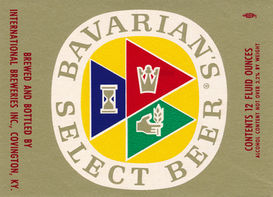
IBI LABELS AT THE BAVARIAN BREWERY PLANT
c. 1960 - 1966. A couple years or so after Bavarian Brewing was sold, IBI began brewing and bottling other brands in the Bavarian Brewery located in Covington, KY. The labels for most of these brands are below. Please note that Iroquois Beer and Iroquois Ale was only bottled in Buffalo, NY; not in Covington or any of the other IBI plants. Some of the brands and accompanying labels that were not obtained, but were probably produced at Bavarian Brewery, were Silver Bar Beer, Stolz Beer, possibly some ales and bock beers. Therefore, besides Bavarian's Select Beer aka Bavarian/s, there were at least about 10 additional brands that were bottled and brewed by IBI in Covington during first half of the 1960s.
c. 1961 - 1966. A couple years or so after Bavarian Brewing was sold, IBI began brewing and bottling other brands in the Bavarian Brewery located in Covington, KY. The labels for most of these brands are below. Please note that Iroquois Beer and Iroquois Ale was only bottled in Buffalo, NY; not in Covington or any of the other IBI plants. Some of the brands and accompanying labels that were not obtained, but were probably produced at Bavarian Brewery, were Silver Bar Beer, Stolz Beer possibly some ales and bock beers. Therefore, besides Bavarian's Select Beer, there least about 10 additional brands that were bottled and brewed by IBI in Covington during first half of the 1960s.









c. 1961 - 1966. As noted, Bavarian's Select Beer (Bavarian/s) was also made at other IBI plants. They included the Krantz / Old Dutch plant in Findlay, OH, the Phoenix plant in Buffalo, NY and the Silver Bar plant in Tampa, FL. Most of the labels for these brands brewed at the Bavarian / Covington plant are shown above. However, additional Bavarian/s labels made at these other plants are available in the above video, Part II.
After 1966. After IBI discontinued its brewery operations and reorganized under a different name into another company in 1966, Bavarian/s continued to be made by other brewers. Initially it was bottled and brewed under a licensing agreement with Associated Breweries, Inc. primarily at the former Sterling Brewery in Evansville, IN, but also in Detroit, MI and possibly in South Bend, IN into the 1970s. However, the aforementioned plants that made Bavarian/s in the early 1970s, under a different name - Bavarian's' Brewing Co. Afterwards, possibly into the early 1980's, Bavarian/s was produced by Iroquois Brewing in Columbus, OH and Dunkirk, NY. Most of the labels for Bavarian's Select Beer that were used in other locations by other brewers outside of Covington, KY, along with some information of these former brewers, can be viewed in aforesaid video. This video also has a number of different variations of labels that are not shown above.
Acknowledgements. Scans of the three Pre-Pro labels, and a few of the labels shortly after Prohibition, were obtained from the collections of Bob Kay's family, Carl Groh and the Schott Family Collection in the Behringer Crawford Museum (bcmuseum.org).


